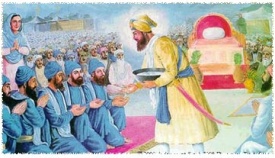Template:AOW37
On Baisakhi Day, March 30, 1699, hundreds of thousands of people gathered around Guru Gobind Singh's divine temporal seat at Anandpur Sahib in northern India. The Guru addressed the Sangat congregation with a most stirring oration on his divine mission of restoring their faith and preserving the Sikh dharma (religion).
After his inspirational discourse, he flashed his unsheathed Kirpan sword and announced that every great deed was preceded by an equally great sacrifice: He demanded the sacrifice of one head for Dharam (path of righteousness}. After some trepidation, one person stood up and offered himself. The Guru took him inside a separate tent. A little later he reappeared with his sword dripping with fresh blood, and asked for another head. One by one four more earnest devotees offered their heads. Every time the Guru took the person inside the tent, he came out with more and more fresh blood dripping from the sword in his hand.
This was the beginning of the ceremony called the Amrit Sanchar. Since 1699, many millions of Sikhs have walked along this same path set by their tenth master. Every year, this important day is now celebrated by Sikhs all over the world on April 14.
Whenever a Sikh feels that he or she is ready to commit to the strict discipline of dharma and feels the deep love and affection for the Guru, he or she will undergo this baptism ceremony of the Khanda (or double-edged sword). With this ceremony comes the devotion to the principles laid down in 1699 by the Guru - Bani, Bana, Kakkar, Rehat and Gurmat. .....More

